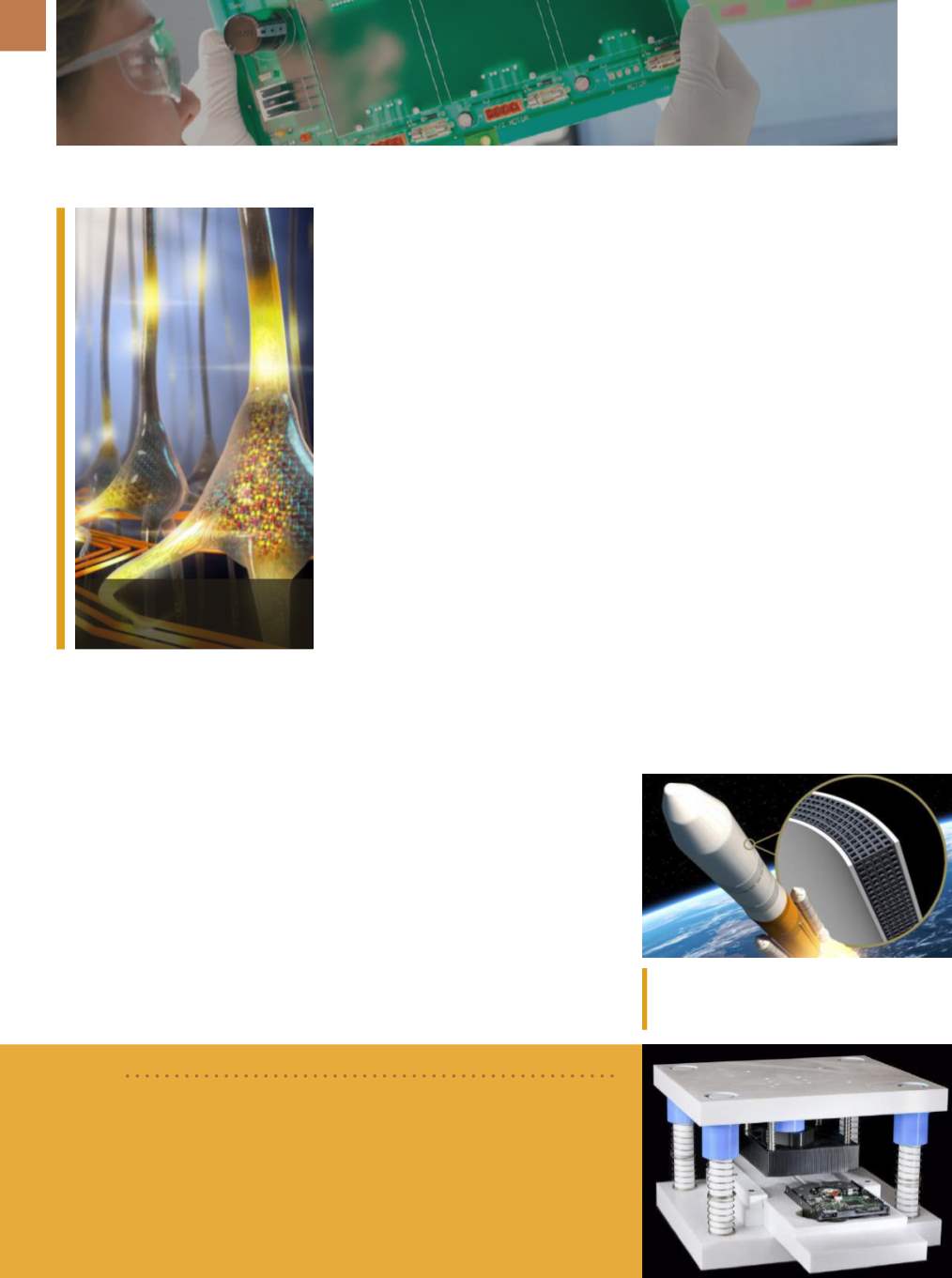

A D V A N C E D M A T E R I A L S & P R O C E S S E S | O C T O B E R 2 0 1 6
1 2
PHASE-CHANGE MATERIAL
MIMICS THE BRAIN
Inspired by brain function, scien-
tists at IBM Research, Switzerland, used
phase-change materials to create ran-
domly spiking artificial neurons, paving
the way to faster cognitive computing
and improved analysis of big data for
the Internet of Things. The materials,
including germanium antimony tellu-
ride, exhibit two stable states—amor-
phous and crystalline. When the IBM
team applied a series of electrical puls-
es to the artificial neurons, the mate-
rial progressively crystallized, causing
neurons to fire. Just like synapses and
neurons in the brain, these artificial
neurons function in an analog rather
than digital way.
The artificial neurons “can per-
form various computational primitives
such as data-correlation detection and
unsupervised learning at high speeds
using very little energy,” explains IBM
Fellow Evangelos Eleftherio. They can
sustain billions of switching cycles—
multiple years of operation—at an
update frequency of 100 Hz, and on av-
erage, each update requires less than
5 pJ of energy and less than 120 µW of
power. While even a single neuron can
be used to detect patterns and discov-
er correlations in real-time streams of
event-based data—analyzing financial
transactions or social media trends, for
example—IBM scientists have demon-
strated that hundreds of neurons can
be organized into populations. For in-
stance, the neurons could be config-
ured for neuromorphic coprocessors
with co-located memory and process-
ing units.
ibm.com.
3D-PRINTED GRID
ABSORBS BAD VIBES
Researchers at ETH Zurich, Swit-
zerland, developed a lattice structure
capable of absorbing a wide range
of vibrations while also serving as a
load-bearing component. In the past,
engineers have used soft materials to
absorb vibrations inmachines, vehicles,
and aircraft that increase fatigue dam-
age andmake environments jarring and
loud. Unlike these soft materials, how-
ever, the rigid lattice could be used to
Artistic rendering of a population
of stochastic phase-change neu-
rons. Courtesy of IBM Research.
Vibration-absorbing lattice, which could
eventually be used in rockets. Courtesy of
3Dsculptor/Shutterstock/Jung-Chew Tse.
BRIEF
Under a new agreement between
Oddello Industries LLC,
Morristown, Tenn.,
and
Oak Ridge National Laboratory
(ORNL), Tenn., a process developed at
ORNL for large-scale recovery of rare earth magnets from used computer hard
drives will undergo industrial testing as part of the DOE’s Critical Materials In-
stitute.
The process recovers the magnets intact, enabling direct reuse by hard
drive manufacturers or in motor assemblies. Magnets can also be resized or
reshaped for alternate uses or processed back to rare earth metal.
ornl.gov.
Model of a punching device to be tested for recovering magnet assemblies.
construct structural components, such
as airplane rotors and helicopter pro-
pellers. Also, the lattice can be designed
to absorb oscillations of a few hundred
to tens of thousands of Hertz—a much
broader range than soft materials can
handle—including audible vibrations,
which are the most undesirable.
The plastic grid, fabricated by 3D
printing, has a lattice spacing of rough-
ly 3.5 mm and is embedded with steel
cubes slightly smaller than dice that
act as resonators. Instead of vibrations
traveling through the whole structure,
they are trapped by the steel cubes and
inner plastic grid rods. Widespread use
of the lattice is limited by its materi-
al properties, which do not yet match
those of components manufactured
by traditional methods. Further, 3D
printing technology is primarily geared
toward small-scale production. Even-
tually, however, applications could in-
clude wind turbine rotors, vehicle and
aircraft construction, and even rockets.
www.ethz.ch.
EMERGING TECHNOLOGY
















